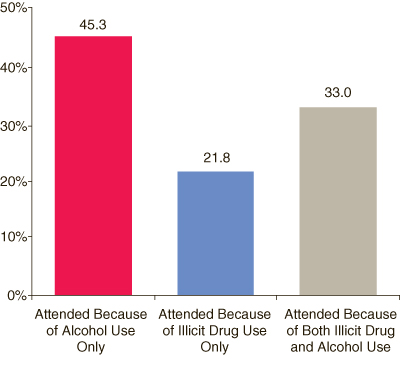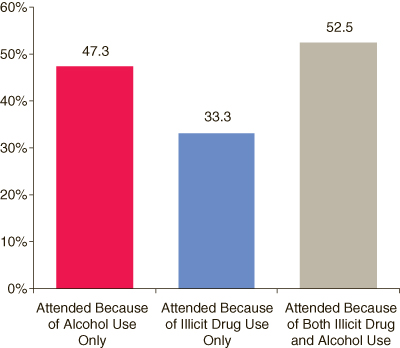
 |
| November 13, 2008 |
|
The National Survey on Drug Use and Health (NSDUH) includes a question for persons aged 12 or older about their participation in the past 12 months in a self-help group for substance use (i.e., alcohol use, illicit drug use, or both). NSDUH also asks questions about past year receipt of treatment for substance use problems in a specialty treatment facility.2
This issue of The NSDUH Report examines the characteristics of persons aged 12 or older participating in self-help groups for substance use in the past year. It also reports on past month alcohol and/or illicit drug use among persons who participated in self-help groups in the past year and on past year receipt of specialty treatment. All findings presented in this report are annual averages based on combined 2006 and 2007 NSDUH data.
An annual average of 5.0 million persons aged 12 or older (2.0 percent of the population in that age group) attended a self-help group in the past year because of their use of alcohol or illicit drugs.3
The majority of people who attended a self-help group for their substance use in the past year were male (66.1 percent) (Table 1). Most attendees (80.2 percent) were over the age of 25, two thirds (67.7 percent) were white, a majority (55.6 percent) lived in a large metropolitan area, and over two thirds (68.1 percent) had a total family income of under $50,000 per year.
| Sociodemographic Characteristic |
Percent of Self-Help Group Participants |
Percent** of Total Population |
|---|---|---|
| Total | 100.0% | 100.0% |
| Gender | ||
| Male | 66.1% | 48.5% |
| Female | 33.9% | 51.5% |
| Age Group in Years | ||
| 12 to 17 | 4.6% | 10.3% |
| 18 to 25 | 15.3% | 13.3% |
| 26 to 49 | 57.4% | 40.6% |
| 50 or Older | 22.8% | 35.9% |
| Race/Ethnicity | ||
| White | 67.7% | 68.3% |
| Black or African American | 15.8% | 11.8% |
| Hispanic or Latino | 12.9% | 13.7% |
| American Indian or Alaska Native | 1.2% | 0.5% |
| Native Hawaiian or Other Pacific Islander | 0.3% | 0.3% |
| Asian | 0.7% | 4.2% |
| Two or More Races | 1.4% | 1.1% |
| County Type | ||
| Large Metropolitan | 55.6% | 53.7% |
| Small Metropolitan | 28.9% | 29.4% |
| Non-Metropolitan | 15.4% | 16.8% |
| Family Income | ||
| Less Than $20,000 | 30.5% | 18.6% |
| $20,000 to $49,999 | 37.6% | 33.7% |
| $50,000 to $74,999 | 13.4% | 17.9% |
| $75,000 or More | 18.5% | 29.8% |
| Source: SAMHSA, 2006 and 2007 NSDUHs. |
Among persons aged 12 or older who attended a self-help group in the past year, 45.3 percent attended a group because of their alcohol use only, and 21.8 percent attended a group because of their illicit drug use only (Figure 1). One third (33.0 percent) attended a group because of their use of both alcohol and illicit drugs.4
 |
| Past Year Self-Help Group Attendees | Percent |
|---|---|
| Attended Because of Alcohol Use Only | 45.3% |
| Attended Because of Illicit Drug Use Only | 21.8% |
| Attended Because of Both Illicit Drug and Alcohol Use | 33.0% |
| Source: SAMHSA, 2006 and 2007 NSDUHs. |
Among past year self-help group participants aged 12 or older, 45.1 percent abstained from substance use in the past month, and the remaining 54.9 percent continued to use substances.
Rates of abstinence differed depending on the substance(s) for which individuals were attending self-help groups. For example, past month abstinence from alcohol and illicit drug use was reported by 33.3 percent of those who attended a self-help group for their illicit drug use only (Figure 2). This compares with 47.3 percent of those who attended a self-help group for their alcohol use only and 52.5 percent of those who attended a self-help group for their use of both alcohol and illicit drugs.
 |
| Past Month Abstention Attendees | Percent |
|---|---|
| Attended Because of Alcohol Use Only | 47.3% |
| Attended Because of Illicit Drug Use Only | 33.3% |
| Attended Because of Both Illicit Drug and Alcohol Use | 52.5% |
| Source: SAMHSA, 2006 and 2007 NSDUHs. |
Almost one third (32.7 percent) of individuals aged 12 or older who attended a self-help group for their substance use in the past year also received specialty treatment for substance use in the past year. About one quarter (26.1 percent) of persons who attended a self-help group for their alcohol use only also received specialty treatment for any substance use, compared with 43.4 percent of those who attended a self-help group because of their illicit drug use only and 32.2 percent of those who attended a self-help group for their use of both alcohol and illicit drugs.
Two thirds (66.0 percent) of persons aged 12 or older who received any alcohol or illicit drug use specialty treatment in the past year also attended a self-help group in the same time frame. Three fourths (75.6 percent) of the persons who received specialty treatment for both alcohol and illicit drug use also attended a self-help group compared with 65.8 percent of those who received specialty treatment for illicit drug use only and 63.6 percent of those who received specialty treatment for alcohol use only.
Recovery from problem substance use and abuse is an ongoing life event that requires long-term support and treatment.5 A substantial body of research has found that attendance at self-help groups improves substance use outcomes, mainly in the form of reductions in the amount used and increases in rates of abstinence.1 Self-help groups often are used in conjunction with specialty treatment and also continue beyond treatment as people go through the recovery process.6
| The National Survey on Drug Use and Health (NSDUH) is an annual survey sponsored by the Substance Abuse and Mental Health Services Administration (SAMHSA). The combined 2006 and 2007 data used in this report are based on information obtained from 135,672 persons aged 12 or older. The survey collects data by administering questionnaires to a representative sample of the population through face-to-face interviews at their place of residence. The NSDUH Report is prepared by the Office of Applied Studies (OAS), SAMHSA, and by RTI International in Research Triangle Park, North Carolina. (RTI International is a trade name of Research Triangle Institute.) Information on the most recent NSDUH is available in the following publication: Office of Applied Studies. (2008). Results from the 2007 National Survey on Drug Use and Health: National findings (DHHS Publication No. SMA 08-4343, NSDUH Series H-34). Rockville, MD: Substance Abuse and Mental Health Services Administration. Information for the earlier NSDUH is available in the following publication: 2006 NSDUH (DHHS Publication No. SMA 07-4293, NSDUH Series H-32) Also available online: http://oas.samhsa.gov. Because of improvements and modifications to the 2002 NSDUH, estimates from the 2002 through 2007 surveys should not be compared with estimates from the 2001 or earlier versions of the survey to examine changes over time. |
| The NSDUH Report is published periodically by the Office of Applied Studies, Substance Abuse and Mental Health Services Administration (SAMHSA). All material appearing in this report is in the public domain and may be reproduced or copied without permission from SAMHSA. Additional copies of this report or other reports from the Office of Applied Studies are available online: http://oas.samhsa.gov. Citation of the source is appreciated. For questions about this report, please e-mail: shortreports@samhsa.hhs.gov.
NSDUH_120 |

This page was last updated on December 30, 2008. |
|
SAMHSA, an agency in the Department of Health and Human Services, is the Federal Government's lead agency for improving the quality and availability of substance abuse prevention, addiction treatment, and mental health services in the United States. 
* PDF formatted files require that Adobe Acrobat Reader® program is installed on your computer. Click here to download this FREE software now from Adobe. |